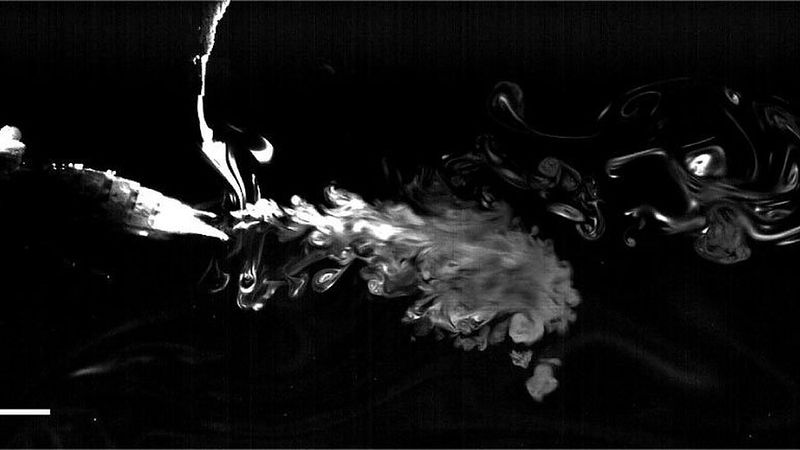Dragonfly Larvae Inspire New Designs for Prosthetic Heart Valves
A new understanding of the mechanics of dragonfly larvae respiration and maneuvering could lead to the next generation of prosthetic heart valves, say Caltech engineers.

Seen as a light-colored plume, water jets out from the back of a larval dragonfly. Credit: Chris Roh and Mory Gharib/Caltech
Mory Gharib (PhD '83), the Hans W. Liepmann Professor of Aeronautics and Bioinspired Engineering in the Division of Engineering and Applied Science, and postdoctoral researcher Chris Roh (MS '13, PhD '17) studied Anisopteran dragonfly larvae, which live in water and both breathe and move by inhaling water, extracting oxygen from it, and then expelling the water back out through a tri-leaflet anal valve that is surprisingly similar in structure to tricuspid human heart valves.
The larvae are able to control the retraction of each of the three leaves individually, and this, Gharib and Roh discovered, gives them fine control over the size and symmetry (or asymmetry) of the valve opening.
"The dragonfly larva is the only insect that uses jet propulsion to move and the only arthropod known to use reciprocal jetting—inhaling and exhaling through the same orifice—for underwater breathing," says Roh, the lead author of a paper on the larval jets that was published online by the journal Bioinspiration & Biomimeticson May 30.
To observe how the larvae directed the flow of water using the leaves on their anal valves, Gharib and Roh set up high-speed cameras around an aquarium filled with a colored dye and tethered 96 dragonfly larvae—one at a time—in front of the cameras using dental wax. They found that when the larvae retracted all three leaves, the water jet flows straight out, pushing the animals straight forward. Retracting just one or two leaves, on the other hand, results in an asymmetric flow, which the larvae use when breathing.
"The way the dragonfly larvae use their unique adaptation to control the jet direction has previously been overlooked," says Gharib, senior author of the paper. "The asymmetry control by the larvae is an intriguing jet-vectoring mechanism, different from those of squids or salps that simply point their funnels or siphons in a desired direction."
Like the anus of the dragonfly larvae, heart valves have two or three leaves (depending on the valve) that control the flow. Gharib and Roh intend to use what they have learned from the dragonflies to engineer a new prosthetic multi-leaf heart valve that can direct jets in specific directions that mimic natural blood flow emerging from the valve, which is never perfectly symmetric. Currently, the unnaturally symmetrical flow of blood emerging from prosthetic valves can cause blood clots to form or even be abrasive to the walls of blood vessels. To cope with this unintended side effect of prosthetic heart valves, patients typically must spend the rest of their lives taking blood-thinning medications.
"The current heart valve design is a one-size-fits-all, where no patient-specific design is considered, and this causes many post-transplant complications," Roh says. "We believe that an intentionally off-centered opening of the heart valve to more closely match the patient's original blood flow will be an important design parameter that can be adjusted based on each patient's heart morphology."